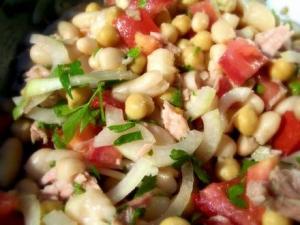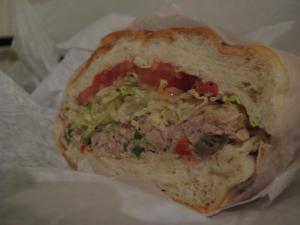Definition: tunny
large sea-fish of the mackerel order, 1530, probably from M.Fr. thon (14c.), from O.Prov. ton, from L. thunnus “a tuna, tunny,” from Gk. thynnos “a tuna, tunny,” possibly in the literal sense of “darter,” from thynein: “dart along.”

Aunt Ellen took the green can and pried it open with one of those old-fashioned can-openers that looked more like a chisel than not. Plop went the pinkish tuna, almost salmon colored, into the pot. With our dirty little hands, we helped stir the flaking fish into the overcooked noodles, long and slippery like earthworms. With another twist of her can-opener, my gentle and practical aunt scooped out cream-of-mushroom soup from a sharp-edged red can and said, “Kids, kids, use a wooden spoon to stir. Please.”
We stirred everything together with the requisite spoon and dumped it into an old Pyrex baking dish that looked like the same one my mother used for chocolate cake. When Aunt Ellen turned her back, to crush the potato chips for the top of the casserole, my cousin Joyce and I gave up on the wooden spoon and smoothed out the thick mixture in the pan with our fingers, giggling as we pawed at each other with our messy hands.
Once the potato chips snuggled into the moistened noodles, the dish went into the oven. After the top browned, with a blackened chip here and there poking out like a submariner’s scope, we sat at the Formica table and ate. Our uncles seemed to swallow most of the casserole in a few enormous bites.
And that’s how most Americans ate tuna until fairly recently. Unless they smeared tuna and mayonnaise on a piece of bread and made a “tunafish” sandwich.
Cousin to the mackerel and friend to fishermen, since prehistoric days the tuna has provided food for humans. Apicius, writer of what many consider to be the first Western cookbook, included many recipes and references to tuna in his De Re Coquinaria (Book X deals with fish).
And today, when a fisherman turns up with nothing on a bad- fish day, why, a cook can do wonders with a can of tuna. But there are moral and conservation issues at work with every can of tuna, with every tuna carcass sold in Japan’s Tsukiji Market in Tokyo.
Six different species of tuna, out of many possible species, fill those cans and fishmongers’ stalls. Ranging in size, depending upon the species, from 20 pounds to 1,500 pounds, tuna is fished throughout the world. Bluefin tuna, long unappreciated in U.S. markets, delights the Japanese and people from the Mediterranean, who pickle that strong‑flavored, red‑fleshed fish. Tuna dominate the Tsukiji Market in Tokyo, for example, and the bluefin now heads toward extinction due to the rapacious appetite for it brought about by the sushi and sashimi craze.

On the other hand, Americans prefer yellow-fin tuna and albacore, both of which yield tender white meat. Other tuna species fished commercially include the bonito, skipjack, and bigeye.
Although tuna in America ends up being mostly a canned affair, on the Pacific coast, fish-markets specialize in widely available fresh tuna. Grilled, roasted, and poached, nothing surpasses fresh tuna. At times, fresh tuna steaks appear in fish markets in other parts of the United States. But if fresh tuna is scarce, canned tuna makes a wonderful base for many excellent dishes.
Lists of great tuna dishes DO NOT include “Tuna‑Noodle Casserole,” like Aunt Ellen’s, ubiquitous in the 1950s in the United States. That recipe, more than any other, single-handedly ruined most people’s attitude toward tuna, canned or fresh. Instead of that stodgy, gelatinous mess, try “Tuna and White Beans,” “Tuna Sandwich Supreme,” “Tuna Sauce for Roast Beef,” and most interesting of all, “Ashanti Stewed Greens.”
With canned tuna, culinary wonders will never cease. And with fresh, anything goes. But consumers need to remember that dolphins unwittingly swim into the nets that catch tuna and drown. (In March 2009, at the World Trade Organization, Mexico brought suit against the United States for the U.S.’s “Dolphin-safe tuna” laws.)
NUTRITION NOTES
A 3‑oz. can of oil‑packed tuna contains165 calories, compared to 135 calorie for water‑packed tuna in similar size cans. One cup of standard tuna salad contains about 375 calories (using regular mayonnaise).

TUNA WITH WHITE BEANS
Serves 4‑6
1½ c. dried white beans (Great Northern or Navy), cooked and drained
5 T. olive oil
1 medium onion, chopped finely
2 cloves garlic, mashed
14‑oz. water‑packed tuna, drained
1½ c. fresh tomatoes, seeded and chopped
¼ t. dried sage
1 T. fresh basil, chopped or 1 t. dried
¼ t. dried hot pepper flakes
Salt and freshly ground black pepper, to taste
4 T. chopped parsley (for garnish)
Fry the onions in 3 T. of olive oil until translucent, about 5 minutes. Stir in the garlic and fry for about 30 seconds. Stir in the tuna, breaking it up with a wooden spoon and cook for 1 minute.
Add the beans and the remaining ingredients (except for the parsley). Simmer for 5 minutes.
Top with the parsley and serve immediately with lots of good bread and a tossed salad.
 TUNA SANDWICH SUPREME
TUNA SANDWICH SUPREME
(Makes 2 sandwiches)
1 7‑oz. can chunk light tuna in spring water, drained
1 small jar pickled artichoke hearts, drained and chopped into quarters
3 T. pitted black olives, sliced
3 T. sliced pimento‑stuffed green olives
2 T. chopped canned pimentos
2 T. capers, drained
¼ c. herbed vinaigrette, homemade or commercial
2 large Kaiser rolls
2 pepperoncini peppers, sliced
Tomato slices and lettuce leaves
Grindings of black pepper
Mix all ingredients except for the vinaigrette and the rolls. Stir in the vinaigrette and mix until all ingredients are moistened. Pile filling onto rolls.
Garnish with the peppers, tomato slices, and lettuce.
TUNA SAUCE FOR ROAST BEEF
Serves 6
1½ lbs. chilled roast beef, thinly sliced
1 c. real mayonnaise, preferably homemade, with 3 T. lemon juice stirred in
7‑oz. can tuna in spring water, drained
5 flat anchovy fillets
1¼ c. extra virgin olive oil
3 T. tiny capers
Salt if necessary
In a blender or food processor, blend the tuna, anchovies, olive oil, and capers into a creamy puree. Stir this mixture into the mayonnaise. Taste for salt.
Spread a thin layer of the sauce on a serving plate and layer the plate with slices of meat. Top the layer of meat with a thick layer of sauce. Repeat until all the meat is layered and covered with the sauce. Refrigerate the meat, tightly covered with plastic wrap, for 24 hours. Before serving, garnish the plate with some capers, lemon slices, and parsley.

ASHANTI STEWED GREENS (From The Art of West African Cooking, by Dinah Ameley Ayensu)
Serves 4 – 6
2 ½ lbs. kale, collard greens, or spinach, cooked until tender, chopped
1 medium onion chopped
½ c. cooking oil (red palm oil, if available)
2 ripe tomatoes, diced
Salt and freshly ground black pepper to taste
1 t. paprika
½ t. ground red pepper
1 c. cooked, flaked codfish
½ c. dried or smoked shrimp
¼ c. vegetable stock (or water)
1 6 ½ –oz. can tuna
Heat oil over medium-high heat in heavy-bottomed skillet and fry onions until golden brown. Add tomatoes, salt, black pepper, paprika, and red pepper. Cook 10 minutes, then add codfish and shrimp. When shrimp are tender, stir in vegetable stock and tuna. Add greens, stir, and cook slowly for 15 minutes. Serve hot with rice (plain or with black-eyed peas), ampesi (boiled root vegetables like cassava, plantain, cocoyam, sweet potato, yam, or green bananas), or cornmeal balls (dokon).
For more canned tuna recipse, see Joie Warner’s Take a Tin of Tuna: 65 Inspired Recipes for Every Meal of the Day, by Joie and Drew Warner (2004). The various tuna packaging companies also have published a number of small booklets on cooking with tuna, which you can find on Amazon.com or eBay.
(Due to family obligations for a few weeks, I’m posting some previous posts that I’ve dusted off and updated. )
© 2010 C. Bertelsen
Love it! This is great. Can’t wait for your book …
Belly sections of tuna are frequently mentioned as a delicacy by ancient Greek writers. Btw, Archestratus includes the following advice on cooking the bonito tuna: “wrap it in fig-leaves with a very little oregano… tie them with a string; then push the fish under hot ashes… and don’t burn it”.
Bean and tuna salad and tuna sandwich are very popular in Greece too, but Ashanti Stewed Greens sound really interesting! :)
And thank you, Mae, for the reminder of Salade Nicoise. One of my favorites! I like olive-oil-packed tuna, but it’s not easily found around here. :-(
Speaking of great things to do with tuna — there’s the French classic Salade Nicoise which traditionally uses canned tuna and lots of vegetables. Virtually the same ingredients as in your white bean dish can make a great cold salad (with or without salad greens). I recognize your roast beef sauce from the Milanese recipe called _vitello tonnato_, which I think you can also make with turkey breast.
Recently Trader Joe and Whole Foods have had very good water-packed tuna without added broth; I think broth spoils the flavor in the more commonly found grocery-store brands. Also they offer some very good olive-oil packed tuna, which some Italian salad recipes require.
Thanks for the good ideas!
I really like the smoked mullet dip they make in Cedar Key, FL, so I might have to give this one a try.
Here is another canned tuna dish that my wife makes, it’s super simple & very cheap but still a crowd pleaser (especially when they think it’s the real deal) so here you go.
http://kingbiscuitpants.wordpress.com/2009/05/16/shus-sneaky-faux-smoked-fish-dip/
I’ll have to check into Cindy. Although, I know for sure there is a Sorry Charlie Day and I did do a post I think about Starkist a while back. I’ll have to check. I had planned on devoting a page to tuna eventually. That’s why I saved this GREAT post of yours:)
Oh, that sounds great! I’m going to have give a whirl. Thanks for sharing.
Is there a National Tuna Month? Or day? or week? Because if there is, you could write about it in the detail you do with all the other topics on your blog.
I will never forget the first time I had fresh tuna caught off Montauk Point on Long Island. The deal was, if I was willing to clean it, I could take as much as I wanted. It was surprisingly easy to clean and fillet. The thing was huge and ever so tasty. Nothing like the canned stuff. My freezer was full!!! It was a long time before I could eat canned tuna and now, thank goodness, when I’m in New York, I can get it fresh daily. I’ll save these recipes, especially the Tuna Sauce for the Roast Beef. It sounds so “Apicius.”
Great recipies I’ll probably try each 7 every one of these. You might get a kick out of this one it was a favorite of my Grandfather’s.
http://kingbiscuitpants.wordpress.com/2009/05/01/grandpas-cheap-easy-tuna-sauce/